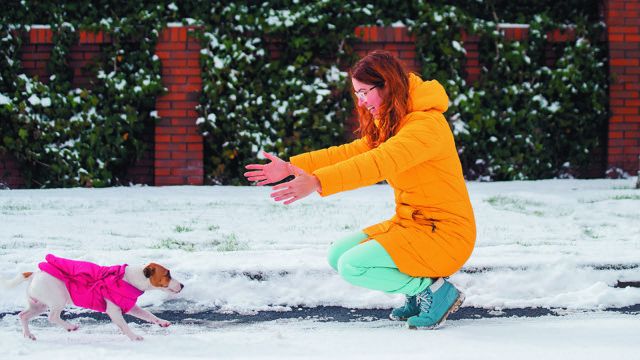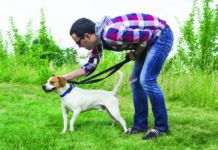For just about everything you teach your dog to do, you’re supposed to praise him after he gets it right. With “Come,” it’s important to praise him before, or at least while you are training him to heed the word. That’s because you want him to know he’s not in trouble.
Too many people, we find, try to get their dog to come with exactly the opposite approach. They start out annoyed and quickly graduate to exasperated. How many people have you heard impatiently telling their dog to come and then saying it more and more angrily when he doesn’t comply? Dogs are not stupid. They’re thinking, “Why should I come? That won’t end well.”
Here’s how to get it right, in four steps.
Step 1. Start out either in a room in your home or an enclosed backyard. When your dog is not expecting it, call out to him: “Max!” Once you have his attention, say, “Come! Goo’ boy!” Make the praise in your voice as animated as possible and keep a happy, expectant expression on your face. Also, drop to one knee if you can and open your arms so that your gesture is as filled with promise as your inflection.
Step 2. As with all cues that you want to teach your dog, step 2 is the trickiest because it’s all on the dog. He has to choose to do what you are asking of him. There’s nothing you can do about it other than wait. In fact, if you try to force it, for example, by moving closer to your dog to see if that will work, the whole exercise becomes too remedial and your dog will not learn.
Step 3. Your dog “gets it” and comes over. (If you start out in a small enough space with the promise of a happy “reunion,” this will most likely happen.)
Step 4. You reward your pet to the hilt, not just with warm praise but with a wonderful treat. He’ll think, “Wow, coming sure does have its perks.”
Ramping it up
It’s one thing to be able to get your dog to cross the living room to you, or from one side of the yard to the other. But that’s just laying the foundation. Getting him to come when you really need him to — perhaps because he’s bothering another dog in the park, or it’s simply time to head back to the car — takes more training. You want to be able to redirect his attention when he’s distracted by something he finds interesting, or fun.
To reach that goal, gradually keep making the stakes higher and higher while training. Keep in mind that this is not “Sit” or “Off,” which happens right next to you. It’s training by remote control.
With that in mind, once your dog really has it down, let him off leash in a place without walls or a fence. When he has wandered from you but is feeling calm and not interested in anything in particular, give him the “Come” cue with all the energy and enthusiasm you did when you first taught him the word. Make sure you’ve got delectable treats with you.
After that works several times on several different days, look for situations in which your pal’s attention is elsewhere. Perhaps he has run from your side to chase a squirrel or sniff another dog. When such a circumstance presents itself, tell him to “Come.” Don’t put any anxiety or urgency into it. And do not say it more than once. All that does is teach him that you’re like a boring toy that keeps making the same sound. Just say the word in your usual enthusiastic, promising tone.
If he comes, great! Pour on the praise and the treats. If he doesn’t, that’s okay. He’ll come another time. Gradually, he’ll fold the cue firmly enough into his memory that he’ll get very good at complying, especially if you keep your tone light and show your pleasure at his ability to follow through.
What if he never fully gets it?
The definition of a trained response, according to authorities such as zookeepers, is an animal’s being able to respond more than 85 percent of the time. In other words, the chances are quite slim that you’re going to get 100 percent compliance, meaning that there’s always going to be some element of risk in using the word “Come.” Thus, use it in conjunction with common sense. Don’t ever let your dog loose near a busy road or in a place that he might encounter aggressive dogs or other aggressive animals. Only let him loose where if he is not able to heed your cue, a disaster won’t follow.





